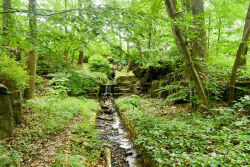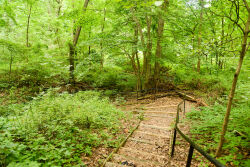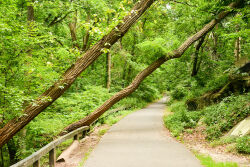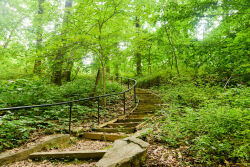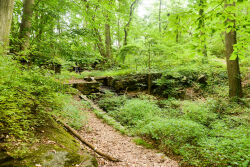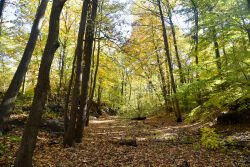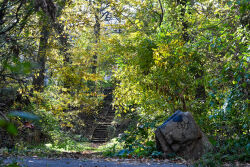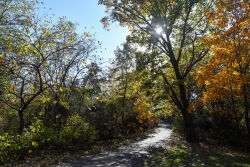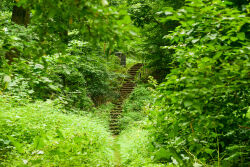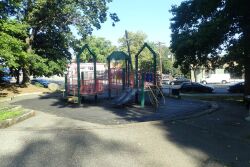Seton Falls Park
The Daily Plant : Friday, April 6, 2001
NRG RESTORATION AND AVIAN MONITORING
With a total of $60 million in ecological restoration projects, Parks' Natural Resources Group is stepping up its monitoring efforts. When NRG restores an ecosystem, be it a salt marsh on Staten Island or kettle ponds in Queens, we need a method of evaluating the success of our work. We need to assess how the ecosystem is different than it was before we set bulldozer to turf or machete to exotic weed. We need to assess this continuously, as the "restored ecosystem" evolves from the relatively ordered, horticultural project that we call "construction" and "planting" into a self-sustaining wildness. The burgeoning science of restoration ecology provides the standard monitoring methodologies that help us gauge our success and correct our failures over time.
One of several taxonomic groups we are monitoring is class Aves, the birds. In some cases, we see dramatic changes in bird populations before and after ecological restoration. When, as at Twin Fields in Forest Park, Queens, we restore freshwater wetlands where once there were soggy baseball fields, we may attract nesting Yellow warblers and Swamp Sparrows at the expense of grazing Canada geese. When we expand the size of a threatened habitat-type, as we will be doing at Four Sparrow Marsh, Brooklyn this summer, no new bird species may appear. It is likely, however, that we will see greater numbers of birds like Sharp-tailed and Seaside sparrows, which are rare to New York City and only nest in native salt marshes.
The changes in bird populations are worthwhile in their own right. Threatened populations may be bolstered, and the foothold of over-dominant species loosened. The dynamics of avian communities also furnish us with more subtle information about the effects of our restoration work. For example, Wood thrushes nesting year after year in a forest indicate that the parasitic generalist, the Brown-headed cowbird, is not foiling the Thrush's breeding efforts. This suggests that the forest is of a certain maturity and tree composition that is Cowbird-unfriendly. Ecological connections like these allow us to use bird populations to learn more about the overall state of the ecosystem. In this way, birds serve as indicators of ecosystem health.
Much is unknown about birds' value as indicator species. Through our avian monitoring program, NRG hopes to learn more about this value, so we can track our restoration success more easily and contribute to applied ecological knowledge. By comparing changes in bird communities with other ecological changes, we will learn more about the functioning of the systems our work has set into motion. NRG's monitoring program tracks water quality, vegetation, and amphibian, fish, and invertebrate communities so we can gain a more complete picture of how all these aspects of an ecosystem fit together and how each one reveals something about the state of the others.
In 2001, NRG will be conducting spring migrant surveys, breeding bird censuses, and wading bird strike studies at Gerritsen Creek/Marine Park and Four Sparrow Marsh, Brooklyn, at Inwood Hill Park, Manhattan, Seton Falls Park, Bronx, and at Alley Pond Park Kettle Ponds in Queens.
If you are a birder with experience you may wish to volunteer in our avian surveys. Please contact Evelyn Fetridge at (212) 360-1448.
By Evelyn D. Fetridge, Bird Monitoring Coordinator, Natural Resources Group
THIRTEEN YEARS AGO IN THE PLANT
(Friday, April 15, 1988)
MEMORIAL SERVICE HELD FOR TREES MASSACRED IN TEMPLE SQUARE
`Donning black arm bands, Commissioner Stern and other concerned neighbors of downtown Brooklyn turned out at Temple Square at Schermerhorn Street and Flatbush Avenue yesterday to pay tribute to four London Plane trees that were illegally cut down on city property earlier this month.
Calling it the Temple Square Massacre, Commissioner Stern remarked, "This is arborcide in the first degree. The loss of a tree is not the loss of a person, but plant life nonetheless deserves our respect. We here highly resolve that these trees shall not have died in vain."
QUOTATION FOR THE DAY
"The Future is something which everyone reaches
at the rate of sixty minutes an hour, whatever he does, whoever he is."
Clive Staples Lewis (1898-1963)
Check out your park's Vital Signs
Clean & Safe
Green & Resilient
Empowered & Engaged Users
Share your feedback or learn more about how this park is part of a
Vital Park System

